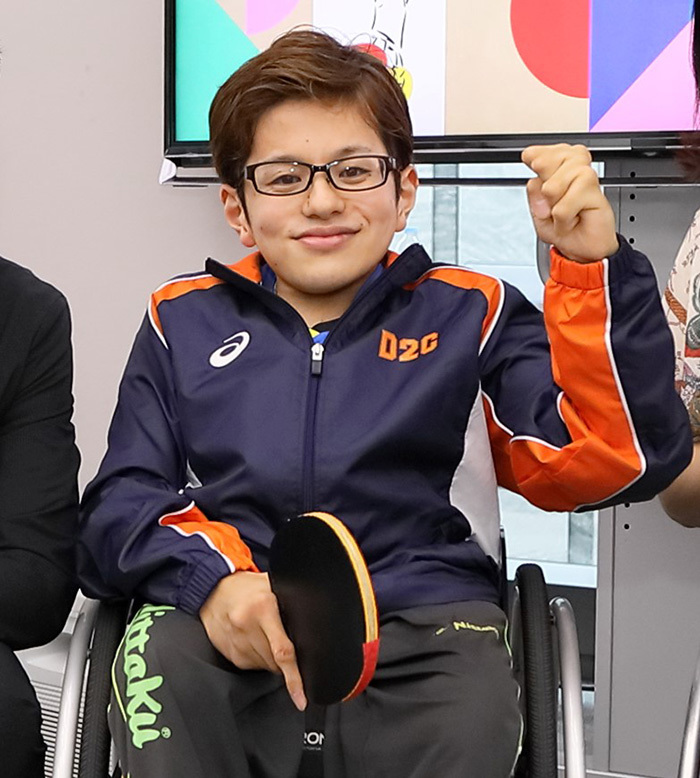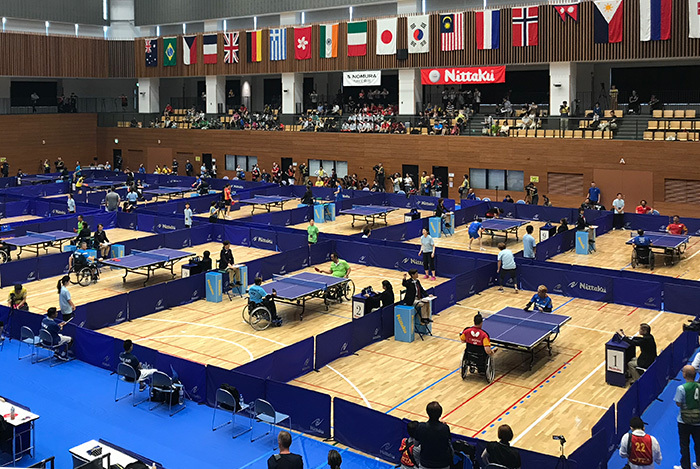Ten People, Ten Styles of Para Table Tennis
"Wheelchair athletes rarely play from a distance. They battle each other at close range with delicate techniques. They use precise ball control to target their opponent's weak spots."
With that, Kentaro Doi flashes a grin. He's a wheelchair para-table tennis player.
Born with osteogenesis imperfecta, he has never been able to walk and uses a wheelchair. He started playing table tennis in sixth grade and now trains daily, aiming to compete in the 2020 Tokyo Paralympics. He says hearing fans shout "Kentaro!" at matches fires him up the most.
Wanting to learn more about Para table tennis, I spoke with him.

When you think of table tennis, images come to mind: players like Harimoto, famous for his "Cho-Rei" shout, engaged in intense rallies with dynamic form far from the table; or the flashy, over-the-top movements seen in the movie adaptation of the manga "Ping Pong." The strong impression is that as rallies intensify, players move further and further away from the table, trading powerful shots.
Recently, I went to see para table tennis at Japan's first ITTF-sanctioned international tournament (the Japan Open). Half of what I saw matched that image, but the other half unfolded in a world quite different from it.
This diversity is precisely what makes it a quintessential para sport. Para table tennis is divided into wheelchair and standing players, with each category further split into five classes based on the degree of disability. Indeed, the wheelchair players didn't move much from near the table.
Incidentally, para table tennis is the third most popular para sport globally in terms of participants. Table tennis is popular in both Europe and Asia, and it's an accessible sport even for those who don't play much (you can play it at hot springs, for instance). It makes sense that many people play it competitively.
The reason Doi chose table tennis is also interesting. He says, "Table tennis is safe." He has a condition where his bones break easily from birth.
"The racket and ball are light, and even if the ball hits you, it doesn't hurt much. Plus, there's no risk of contact with the opponent. It's relatively safe."
Indeed, sports like wheelchair basketball or wheelchair rugby involve intense collisions and falls, making them completely different from table tennis. Table tennis is truly a deeply inclusive sport that people of all ages and genders can enjoy.
Playing Styles Are Diverse

Now, let's touch a bit more on the Japan Open I watched this time.
The venue was the Minato Ward Sports Center near Tamachi Station in Tokyo.
Taking the brand-new elevator up to the 5th floor, I spotted the "Butterfly Madam" near the competition entrance. A veteran player with high recognition, she competes in the wheelchair class and was being greeted by other players and staff throughout the venue (her distinctive style makes her unforgettable once seen. Definitely search for "Butterfly Madam").
I visited on a preliminary day. Fourteen ping pong tables were lined up in the venue. Wheelchair class matches were happening in the back, while standing class matches were taking place in the front area, all happening simultaneously.
The moment I entered, I was overwhelmed. So many matches were happening simultaneously; I didn't know where to look first. Which class was progressing how far...?
I first focused on the closest table tennis match. One player was hitting the ball while moving with a cane. Their opponent wasn't using a cane or wearing a prosthetic leg. Though they were in the same class, it seemed odd at first glance.
But then I realized: the degree of disability varies from person to person. The "classification" system in para sports exists to ensure athletes with diverse disabilities can compete fairly. Within that framework, each athlete uses the equipment they need, and their differences make sense when you consider diversity.
Shifting my gaze to the adjacent table tennis table, I noticed that not only the equipment but also the playing styles of each athlete varied immensely. They skillfully covered their own weaknesses and played deftly. The matches unfolded with a broader range of playing styles than just the so-called defensive-style tactics.
Looks gentle, but it's actually intense
Next, I turned my attention to the wheelchair class matches. At first glance, these seemed quiet. There was no loud scraping of wheels. Players positioned their wheelchairs close to the table, playing while leaning their bodies against it. This was vastly different from my preconceived image.

"Moving the wheelchair carries a big risk," explained player Doi.
Because players position themselves close to the table, the distance between them is short, and the speed of the returned balls is high. The ball you hit comes right back. So, if you're maneuvering your wheelchair, you're likely to be late for the next return.
"Since wheelchair players are closer to the table, balls hit deep to the edge come right at your body, making them hard to return. Those are the deep balls. I persistently hit those difficult balls back at my opponent to force their mistakes."
In the match footage Doi showed us, he was indeed hitting deep balls near his opponent's body over and over. Then, the moment a slightly floated ball came, he'd smash it hard. "It's coming... Yes!" Even the viewers clenched their fists. I see.
"I basically don't move my wheelchair, but sometimes I do."
In the next clip, he moved all the way to the edge of the table to hit a shot. It was a point-winning strike, but if the ball had been returned, the front of the court would have been wide open. He took the risk because he saw the opponent's position and saw an opportunity.
Moreover, he usually plays with the brake on one wheel of his wheelchair engaged. Meaning he released the brake in that split second, moved his wheelchair, and hit the ball – a quick move...
At the Japan Open, I didn't fully grasp the strategic back-and-forth between wheelchair players and just watched from a distance, but this sport looks deceptively calm yet is actually cunning and tough.
You can enjoy it by reading the strategy from the player's perspective
I asked Doi where the best place is to watch para table tennis.
"For me, it's either directly behind or from above. Behind you get a view close to the player's perspective and can really enjoy the match. From above, you can see where the ball bounces and tell when they're attacking with deep shots."
I see, I see. I realized I'd been focusing only on the players' big body movements. You can actually enjoy it by reading the strategy from the player's perspective.
The tables used in Para Table Tennis are almost identical to standard ones. It's that same size many people have used for hot spring table tennis or similar games. The rules are also nearly the same as the general ones.
Next year's championship, where only the top players from each class around the world are allowed to compete, will be held at the Tokyo Metropolitan Gymnasium, near the National Stadium. At this Japan Open, Japanese players made significant strides, spurred on by the local cheers. The support will surely encourage the Japanese players at the main event too.
"I'd be truly happy to compete and hear the cheers calling my name at the venue," said player Doi, a smile spreading across his face.
Seeing Japanese players perform right before your eyes is sure to be a thrilling experience.
Was this article helpful?
Newsletter registration is here
We select and publish important news every day
For inquiries about this article
Author

Momoko Nakai
Dentsu Inc.
After working in HR recruitment, I was involved in brand strategy and media strategy for a foreign-affiliated food and beverage company. Subsequently, I engaged in research focused on the period after 2020, broad-area PR strategy and activities, and area branding operations. I have been in my current position since February 2016. I worked on client projects and initiatives related to culture and parasports leading up to 2020.

